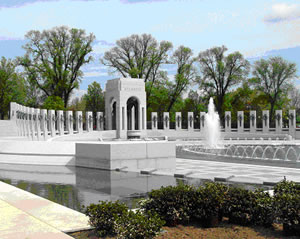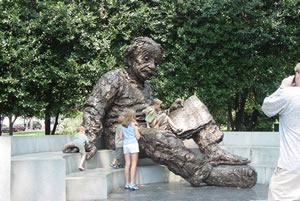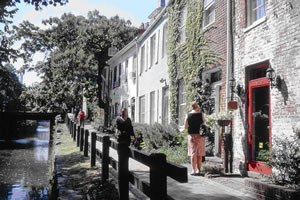|
Learn about
Washington, DC, by reading A Capital Idea For a Trip by
Charlie Spence, Aviation Writer and IFA Member. It features a
mini, but thorough tour of the destination, plus all you'll need
to know to plan your trip including getting there, objective
information on places to stay and eat, and things to do. At the
end of the article, we've provided a summary of the contact
information for your easy reference. Enjoy!
A
Capital Idea For a Trip!
Whether or not you have visited the
Nation's Capital in the past, there are at least two new reasons for
making a flight to Washington, DC soon: the new World War II memorial
on the National Mall to finally honor those who have been called 'the
greatest generation,' and the Smithsonian Air And Space Museum Stephen
Udvar Hazy Center annex at Dulles Airport.
The WWII memorial was officially
dedicated on Memorial Day 2004, which launched a long awaited salute
to the heroism of this generation. Visitors may tour the memorial and
participate in walking tours, enjoy special exhibitions and enjoy
different events, all geared to honoring the World War II
participants. Some hotels offer special 'Greatest Generation' packages
and many restaurants also are offering specials.
The memorial is located on the Mall
between the Lincoln Memorial and the Washington Monument. With its
fountains, granite pillars and a wall with 4,000 gold stars to signify
the 400,000 Americans who lost their lives, it is both a reverent
structure and a proud remembrance of the heroic actions and sacrifices
made by this generation. It honors the 16 million Americans who served
in uniform and the millions more who sacrificed on the home front. Two
43-foot pavilions and two 70-foot flagpoles, framing the entrance,
mark the memorial's north and south entrances. Operated by the
National Park Service, the Memorial is open 24 hours a day, seven days
a week. Try to visit it at night as well as during the day for a
particularly impressive sight.

The new World War II memorial recognizes what has been called 'the
greatest generation.'
Photo from Washington Convention and Tourist Corporation
The new World War II memorial
recognizes what has been called 'the greatest generation.'
The Smithsonian Air and Space Museum
has always been one of the most popular destinations for residents as
well as visitors and the addition of the Udvar Hazy Center at Dulles
International Airport makes this even more of a top attraction. The
center is named for the person who made the major financial
contribution for the facility. The Center is providing space for many
of the aviation treasures that heretofore were stored in the
Smithsonian's Silver Hills restoration shop. Here you will see many
and varied aircraft including the Enola Gay, the plane used to
drop the first atomic bomb on Japan that brought the end to the
conflict, and the recently retired Supersonic Transport. Shuttle buses
can take you from the downtown Air and Space Museum to the Dulles
facility.
These two new attractions in
Washington are enough to consume much of your trip time but there is a
myriad of other structures, statues, museums and centers of power to
fill your days as long as you might be able to stay.
The National Mall, in addition to now
holding the WW II memorial, has other must-see symbols of American
history. The Mall stretches from 3rd Street N.W. to 14th
Street between Independence and Constitution Avenues. That site was
laid out in the city planning for the purposes of rallies and
demonstrations. Although this is the official designation of the Mall,
locals widely use the term to refer to the expanse of monuments and
statues from the grounds of the Capitol Building on the east to the
Lincoln Memorial on the west. The Washington Monument towers 555 feet
above the Mall at 15th Street. (It will be closed until
January 2005 for installation of new security barriers.) Farther west
at Constitution Avenue and Henry Bacon Drive is what is often referred
to as the 'Wall,' where the names of those killed, were prisoners, or
missing in action in the Vietnam war are listed chronologically on the
black granite forming a V-shaped memorial. Not far away is the Vietnam
Women's Memorial honoring, the service women and nurses who served in
the conflict.
Other memorials you might want to
visit include the Jefferson on the Tidal Basin, the Marine Corps
Monument of the flag raising on Iwo Jima, which is adjacent to the
Arlington National Cemetery, and the Franklin D. Roosevelt Memorial
consisting of four 'rooms' to signify the unprecedented four terms of
this president.
 
Photos from
Washington Convention and Tourist Corporation
Not all the monuments and statues in
Washington honor government dignitaries. In this city of monuments you
will find many like this tribute to Albert Einstein. Walk along the
path between quaint houses and the C&O Canal in the Georgetown section
of Washington, the original town in Maryland around which the District
of Columbia was formed.
The Holocaust Memorial traces the
story of Jewish persecution under the Nazi regime. The Spy Museum
reveals some of the secret ways intelligence is gathered. Almost every
government building has tours. You can watch money being printed in
the morning and in the afternoon see the FBI exhibit of John Dillinger
bank heists.
There are at least 40 additional
memorials scattered throughout the area ranging from the Journalists
Memorial and the Robert E. Lee House to the USS Maine Memorial and the
Woman's Titanic Memorial. But Washington is much more than memorials.
There's everything from watching government in action (or inaction
depending on your point of view) to plays and musicals, and dining at
restaurants where the persons at the next table might be foreign
ambassadors, power brokers, agency heads or member of Congress.
Trying to decide what to take in and
what to delay until a future trip can be overwhelming. Your best bet
is to determine whether you want a sightseeing journey, a history
tour, or close-up look at your government. Either way, a tour might be
your best bet. Your first stop could be the Visitors Center in the
Ronald Reagan Building for guidebooks, maps, and any other help you
might want.
A one-day tour covers the U.S.
Capitol, Supreme Court, and Library of Congress in the morning. At all
of these sights, be ready for delays and security searches. Security
is very tight but once inside the buildings you will find the
experience worth the wait. Guided tours of the Capitol Building take
about 45 minutes, and like all government facilities, are free.
Lunch would be normally at the Union
Station, a beautifully restored railroad station only about two blocks
from the Capitol Building and the Senate office buildings. Afternoon
will cover the National Gallery of Art and the Smithsonian Museums.
There are 14 Smithsonian Museums and it would be impossible to visit
them all in one afternoon, particularly if you select the Air and
Space Museum, which can entrance pilots for hours.
For night life head for Georgetown,
Adams Morgan, or Dupont Circle areas, all trendy neighborhoods known
for their taverns, restaurants, shopping and clubs.
The Metro rail subway or taxis are the
best ways to get around the city. Taxis have the zone system of fares,
meaning that the fare is the same within a zone but adds the second
zone fare if you cross the zone line. You'll pay more going two or
three blocks crossing a zone line than you might when traveling much
farther within a zone. Check your cab driver about fares.
Washington has many fine hotels and so
do the suburbs. Rates for good hotels outside the District generally
are less but you also have the added cost and some time constraints
getting to the places you want to visit.
Flying to Washington isn't quite as
easy as it was prior to the 9-ll terrorist attacks. Before that day
that changed our lives you could fly your approach along the Potomac
River and catch a good aerial view of the city going in to Reagan
National Airport. Now that's off limits to all general aviation. There
is also an Air Defense Identification Zone (ADIZ) around the entire
area. Three general aviation airports once convenient are now closed
to itinerant traffic - College Park (CGS), Washington Executive/Hyde
Field (W32), and Potomac Airfield (VKX). Others in the ADIZ, like
Montgomery County, are available but you must be on a flight plan,
have a discrete transponder code and two-way communication. Make sure
you know the boundaries of the ADIZ and the specific routes into those
airports that are open. The natives don't like to hear the sound of
jet fighters flying low over their homes to escort errant flights
away.
Your best bet might be to stop at the
Frederick Municipal Airport about 30 miles north of the city. Since
the restrictions around Washington, this airport has seen roughly
twice its normal activity. Commuter trains are available from
Frederick to Union Station on Capitol Hill in the District.
Tourism, along with politics and
government, is a vital part of the Nation's Capital so the city
officially and businesses in general are geared to provide a welcome
atmosphere for the visitor. Before starting your trip, visit the
tourism web site,
www.washington.org, and get the answers to many questions and fine
suggestions for scheduling tours, finding lodging, and getting around.
Details
Getting There:
The
Frederick Municipal Airport is
considered one of the finest general aviation airports in the East. It
has full FBO services 06:30 to 21:00 daily.
Runway 5/23 is 5,220' x 100' with ILS
approach to runway 23 on 110.3 frequency. Runway 5 has a GPS approach.
Runway 12/30 is 3,600' x75'. Taxiways are 35' wide. Field elevation is
304' MSL. VOR on the field frequency 109.0 Unicom 123.0
Airport is base for Maryland State
Police Trooper III MEDIVAC helicopter.
Landing Fee: none. Parking/tie down:
$6 singles, $10 twins, $15 turbos.
Other Airports
Other airports in the area might be
convenient for you but are within the ADIZ, which you might want to
avoid. Among them are College Park, Suburban, Montgomery County
Airpark, Leesburg, Manassas, Dulles International, and
Baltimore/Washington International. Reagan Washington National is
closed to general aviation. College Park is accessible only to
pilots who have gone through special security clearance and
training. All the others are open to GA but a clear knowledge of the
ADIZ is needed. You need a VFR-ADIZ or IFR flight plan; activate the
VFR prior to entering the ADIZ, keep radio contact with Potomac
Approach and continue squawking a discreet code. Unless you know the
ADIZ rules you will do yourself and others a favor by staying clear
of it.
Where to Stay:
You have a wide, wide variety of
facilities in the area, including fine hotels in suburban Maryland and
Virginia. Here are just a few in the District of Columbia by location:
Foggy Bottom Area
- Best Western, rates from $119
- Doubletree Suites, rates from $159
- Marriott Washington, rates from $109
- Washington Suites, rates from $149
Dupont Circle Area
- Courtyard by Marriott, rates from
$89
- Hilton Washington, rates from $165
- Radison Barcelo, rates from $239
Downtown
- Capital Hilton, rates from $99
- Hay Adams, rates from $259
- Holiday Inn, rates from $80
Rates may vary with season and are
subject to change.
Check rates and make reservations plus reserve a rental car through
the
IFA Online Travel Booking Service. Deep
discounts may apply.
Places to Eat:
Downtown
- District Chop House- entrees $16-25.
- Occidental Grill - walls practically
papered with pictures of Washington bigwigs.
- Old Ebbitt Grill - here since 1846.
Capitol Hill Area
- The Monicle - American classic food
but the people you see might be even more interesting.
- Caf' Berlin - among the few German
restaurants in town, Classics like Wiener Schnitzel.
Adams Morgan Area
- Felix - elegant nightspot. Try the
saut'ed shrimp with angel hair pasta.
Notice: This information is current as of September 2004. It is recommended that you contact the numbers, and/or visit the websites above to determine any changes to the information.
|